Report on Developing Effective Working Relationships with Stakeholders
VerifiedAdded on 2021/02/19
|10
|2491
|43
Report
AI Summary
This report provides a comprehensive analysis of developing effective working relationships with stakeholders. It begins by outlining stakeholder mapping techniques such as Power vs. Interest and Influence vs. Impact grids, along with the skills needed to enhance stakeholder relationships, including open communication, building trust, and conflict resolution strategies. The report then explores different methods of stakeholder consultation, detailing their advantages and limitations, and the potential consequences of inadequate consultation. The second part identifies key stakeholders, their roles and responsibilities, and areas where collaboration can be beneficial. The report also discusses the importance of mutual trust and respect, accounting for stakeholder advice, and minimizing conflicts. Finally, it examines how to improve stakeholder relationships through feedback mechanisms and proactive communication of changes. The conclusion summarizes the key findings and emphasizes the importance of effective stakeholder engagement for organizational success, supported by references to relevant academic sources.

DEVELOPING WORKING
RELATIONSHIPS WITH STAKEHOLDERS
RELATIONSHIPS WITH STAKEHOLDERS
Paraphrase This Document
Need a fresh take? Get an instant paraphrase of this document with our AI Paraphraser
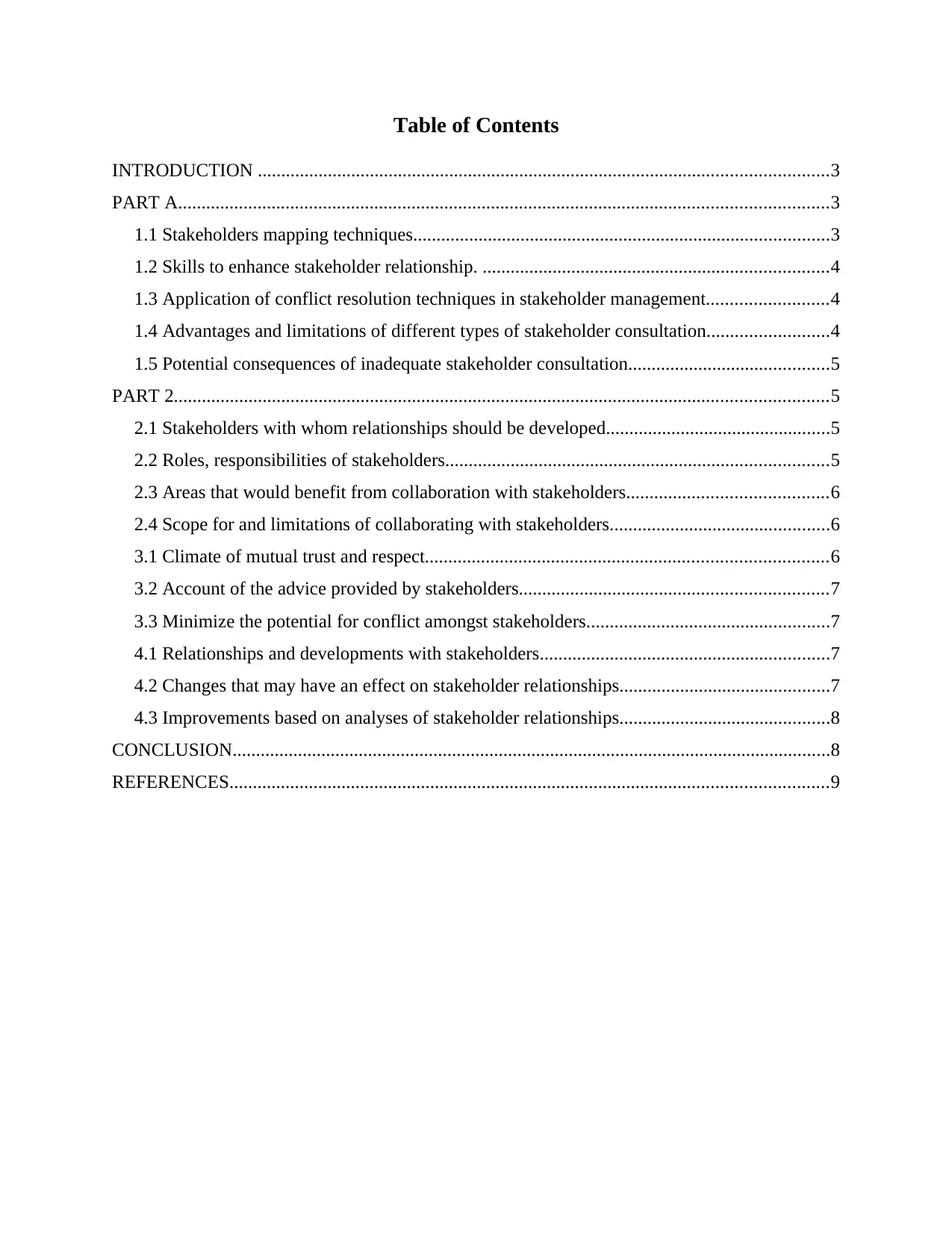
Table of Contents
INTRODUCTION ..........................................................................................................................3
PART A...........................................................................................................................................3
1.1 Stakeholders mapping techniques.........................................................................................3
1.2 Skills to enhance stakeholder relationship. ..........................................................................4
1.3 Application of conflict resolution techniques in stakeholder management..........................4
1.4 Advantages and limitations of different types of stakeholder consultation..........................4
1.5 Potential consequences of inadequate stakeholder consultation...........................................5
PART 2............................................................................................................................................5
2.1 Stakeholders with whom relationships should be developed................................................5
2.2 Roles, responsibilities of stakeholders..................................................................................5
2.3 Areas that would benefit from collaboration with stakeholders...........................................6
2.4 Scope for and limitations of collaborating with stakeholders...............................................6
3.1 Climate of mutual trust and respect......................................................................................6
3.2 Account of the advice provided by stakeholders..................................................................7
3.3 Minimize the potential for conflict amongst stakeholders....................................................7
4.1 Relationships and developments with stakeholders..............................................................7
4.2 Changes that may have an effect on stakeholder relationships.............................................7
4.3 Improvements based on analyses of stakeholder relationships.............................................8
CONCLUSION................................................................................................................................8
REFERENCES................................................................................................................................9
INTRODUCTION ..........................................................................................................................3
PART A...........................................................................................................................................3
1.1 Stakeholders mapping techniques.........................................................................................3
1.2 Skills to enhance stakeholder relationship. ..........................................................................4
1.3 Application of conflict resolution techniques in stakeholder management..........................4
1.4 Advantages and limitations of different types of stakeholder consultation..........................4
1.5 Potential consequences of inadequate stakeholder consultation...........................................5
PART 2............................................................................................................................................5
2.1 Stakeholders with whom relationships should be developed................................................5
2.2 Roles, responsibilities of stakeholders..................................................................................5
2.3 Areas that would benefit from collaboration with stakeholders...........................................6
2.4 Scope for and limitations of collaborating with stakeholders...............................................6
3.1 Climate of mutual trust and respect......................................................................................6
3.2 Account of the advice provided by stakeholders..................................................................7
3.3 Minimize the potential for conflict amongst stakeholders....................................................7
4.1 Relationships and developments with stakeholders..............................................................7
4.2 Changes that may have an effect on stakeholder relationships.............................................7
4.3 Improvements based on analyses of stakeholder relationships.............................................8
CONCLUSION................................................................................................................................8
REFERENCES................................................................................................................................9
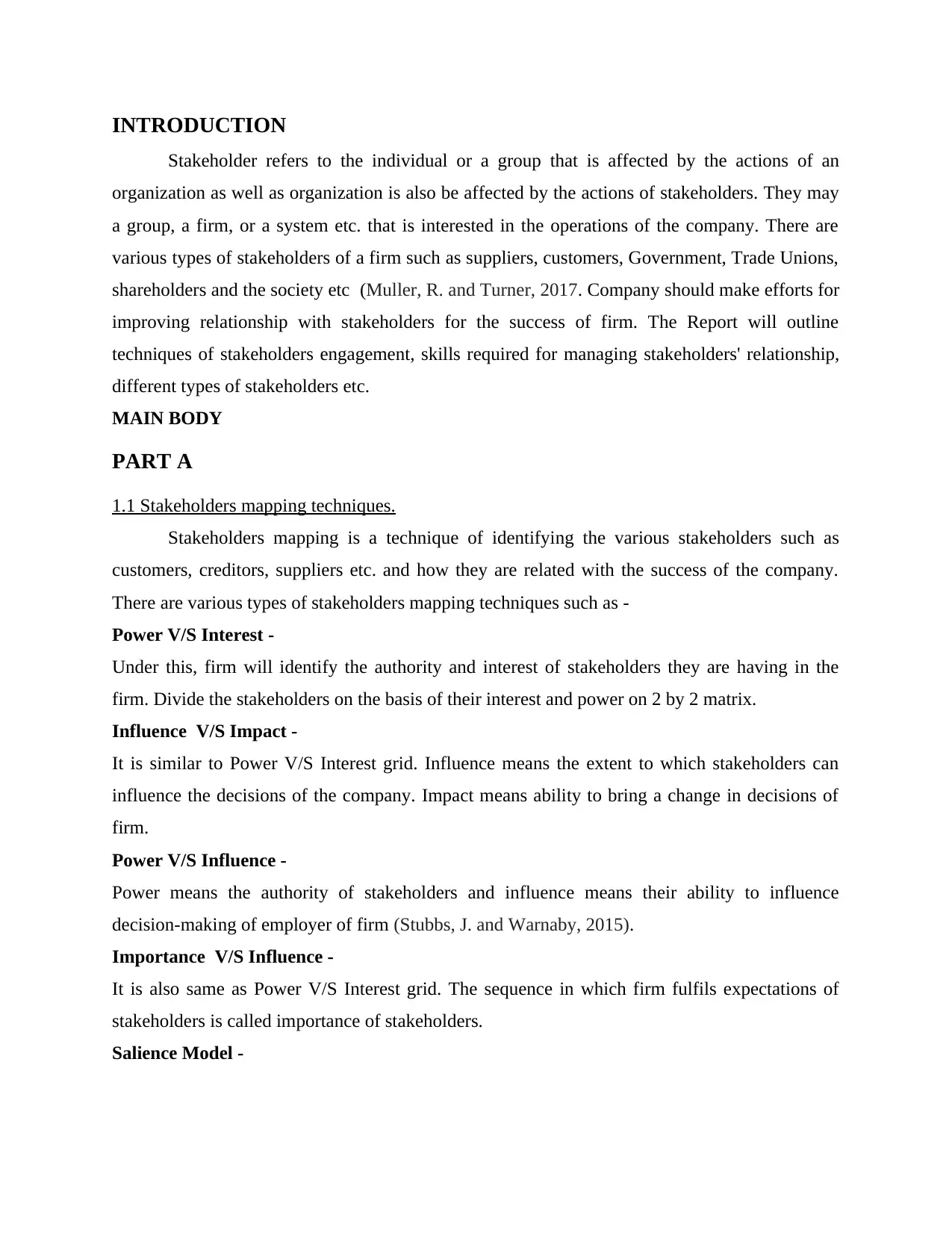
INTRODUCTION
Stakeholder refers to the individual or a group that is affected by the actions of an
organization as well as organization is also be affected by the actions of stakeholders. They may
a group, a firm, or a system etc. that is interested in the operations of the company. There are
various types of stakeholders of a firm such as suppliers, customers, Government, Trade Unions,
shareholders and the society etc (Muller, R. and Turner, 2017. Company should make efforts for
improving relationship with stakeholders for the success of firm. The Report will outline
techniques of stakeholders engagement, skills required for managing stakeholders' relationship,
different types of stakeholders etc.
MAIN BODY
PART A
1.1 Stakeholders mapping techniques.
Stakeholders mapping is a technique of identifying the various stakeholders such as
customers, creditors, suppliers etc. and how they are related with the success of the company.
There are various types of stakeholders mapping techniques such as -
Power V/S Interest -
Under this, firm will identify the authority and interest of stakeholders they are having in the
firm. Divide the stakeholders on the basis of their interest and power on 2 by 2 matrix.
Influence V/S Impact -
It is similar to Power V/S Interest grid. Influence means the extent to which stakeholders can
influence the decisions of the company. Impact means ability to bring a change in decisions of
firm.
Power V/S Influence -
Power means the authority of stakeholders and influence means their ability to influence
decision-making of employer of firm (Stubbs, J. and Warnaby, 2015).
Importance V/S Influence -
It is also same as Power V/S Interest grid. The sequence in which firm fulfils expectations of
stakeholders is called importance of stakeholders.
Salience Model -
Stakeholder refers to the individual or a group that is affected by the actions of an
organization as well as organization is also be affected by the actions of stakeholders. They may
a group, a firm, or a system etc. that is interested in the operations of the company. There are
various types of stakeholders of a firm such as suppliers, customers, Government, Trade Unions,
shareholders and the society etc (Muller, R. and Turner, 2017. Company should make efforts for
improving relationship with stakeholders for the success of firm. The Report will outline
techniques of stakeholders engagement, skills required for managing stakeholders' relationship,
different types of stakeholders etc.
MAIN BODY
PART A
1.1 Stakeholders mapping techniques.
Stakeholders mapping is a technique of identifying the various stakeholders such as
customers, creditors, suppliers etc. and how they are related with the success of the company.
There are various types of stakeholders mapping techniques such as -
Power V/S Interest -
Under this, firm will identify the authority and interest of stakeholders they are having in the
firm. Divide the stakeholders on the basis of their interest and power on 2 by 2 matrix.
Influence V/S Impact -
It is similar to Power V/S Interest grid. Influence means the extent to which stakeholders can
influence the decisions of the company. Impact means ability to bring a change in decisions of
firm.
Power V/S Influence -
Power means the authority of stakeholders and influence means their ability to influence
decision-making of employer of firm (Stubbs, J. and Warnaby, 2015).
Importance V/S Influence -
It is also same as Power V/S Interest grid. The sequence in which firm fulfils expectations of
stakeholders is called importance of stakeholders.
Salience Model -
⊘ This is a preview!⊘
Do you want full access?
Subscribe today to unlock all pages.

Trusted by 1+ million students worldwide
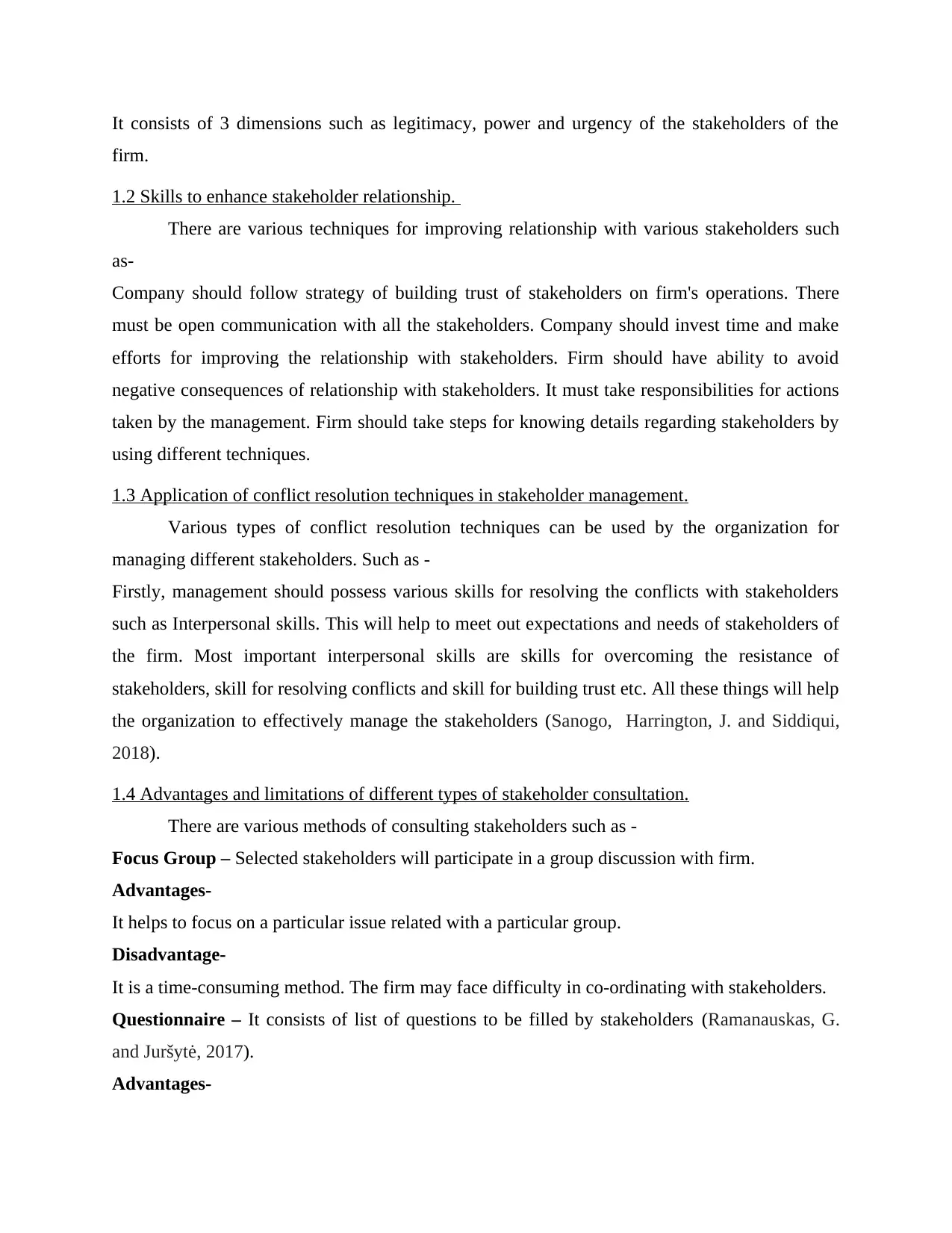
It consists of 3 dimensions such as legitimacy, power and urgency of the stakeholders of the
firm.
1.2 Skills to enhance stakeholder relationship.
There are various techniques for improving relationship with various stakeholders such
as-
Company should follow strategy of building trust of stakeholders on firm's operations. There
must be open communication with all the stakeholders. Company should invest time and make
efforts for improving the relationship with stakeholders. Firm should have ability to avoid
negative consequences of relationship with stakeholders. It must take responsibilities for actions
taken by the management. Firm should take steps for knowing details regarding stakeholders by
using different techniques.
1.3 Application of conflict resolution techniques in stakeholder management.
Various types of conflict resolution techniques can be used by the organization for
managing different stakeholders. Such as -
Firstly, management should possess various skills for resolving the conflicts with stakeholders
such as Interpersonal skills. This will help to meet out expectations and needs of stakeholders of
the firm. Most important interpersonal skills are skills for overcoming the resistance of
stakeholders, skill for resolving conflicts and skill for building trust etc. All these things will help
the organization to effectively manage the stakeholders (Sanogo, Harrington, J. and Siddiqui,
2018).
1.4 Advantages and limitations of different types of stakeholder consultation.
There are various methods of consulting stakeholders such as -
Focus Group – Selected stakeholders will participate in a group discussion with firm.
Advantages-
It helps to focus on a particular issue related with a particular group.
Disadvantage-
It is a time-consuming method. The firm may face difficulty in co-ordinating with stakeholders.
Questionnaire – It consists of list of questions to be filled by stakeholders (Ramanauskas, G.
and Juršytė, 2017).
Advantages-
firm.
1.2 Skills to enhance stakeholder relationship.
There are various techniques for improving relationship with various stakeholders such
as-
Company should follow strategy of building trust of stakeholders on firm's operations. There
must be open communication with all the stakeholders. Company should invest time and make
efforts for improving the relationship with stakeholders. Firm should have ability to avoid
negative consequences of relationship with stakeholders. It must take responsibilities for actions
taken by the management. Firm should take steps for knowing details regarding stakeholders by
using different techniques.
1.3 Application of conflict resolution techniques in stakeholder management.
Various types of conflict resolution techniques can be used by the organization for
managing different stakeholders. Such as -
Firstly, management should possess various skills for resolving the conflicts with stakeholders
such as Interpersonal skills. This will help to meet out expectations and needs of stakeholders of
the firm. Most important interpersonal skills are skills for overcoming the resistance of
stakeholders, skill for resolving conflicts and skill for building trust etc. All these things will help
the organization to effectively manage the stakeholders (Sanogo, Harrington, J. and Siddiqui,
2018).
1.4 Advantages and limitations of different types of stakeholder consultation.
There are various methods of consulting stakeholders such as -
Focus Group – Selected stakeholders will participate in a group discussion with firm.
Advantages-
It helps to focus on a particular issue related with a particular group.
Disadvantage-
It is a time-consuming method. The firm may face difficulty in co-ordinating with stakeholders.
Questionnaire – It consists of list of questions to be filled by stakeholders (Ramanauskas, G.
and Juršytė, 2017).
Advantages-
Paraphrase This Document
Need a fresh take? Get an instant paraphrase of this document with our AI Paraphraser
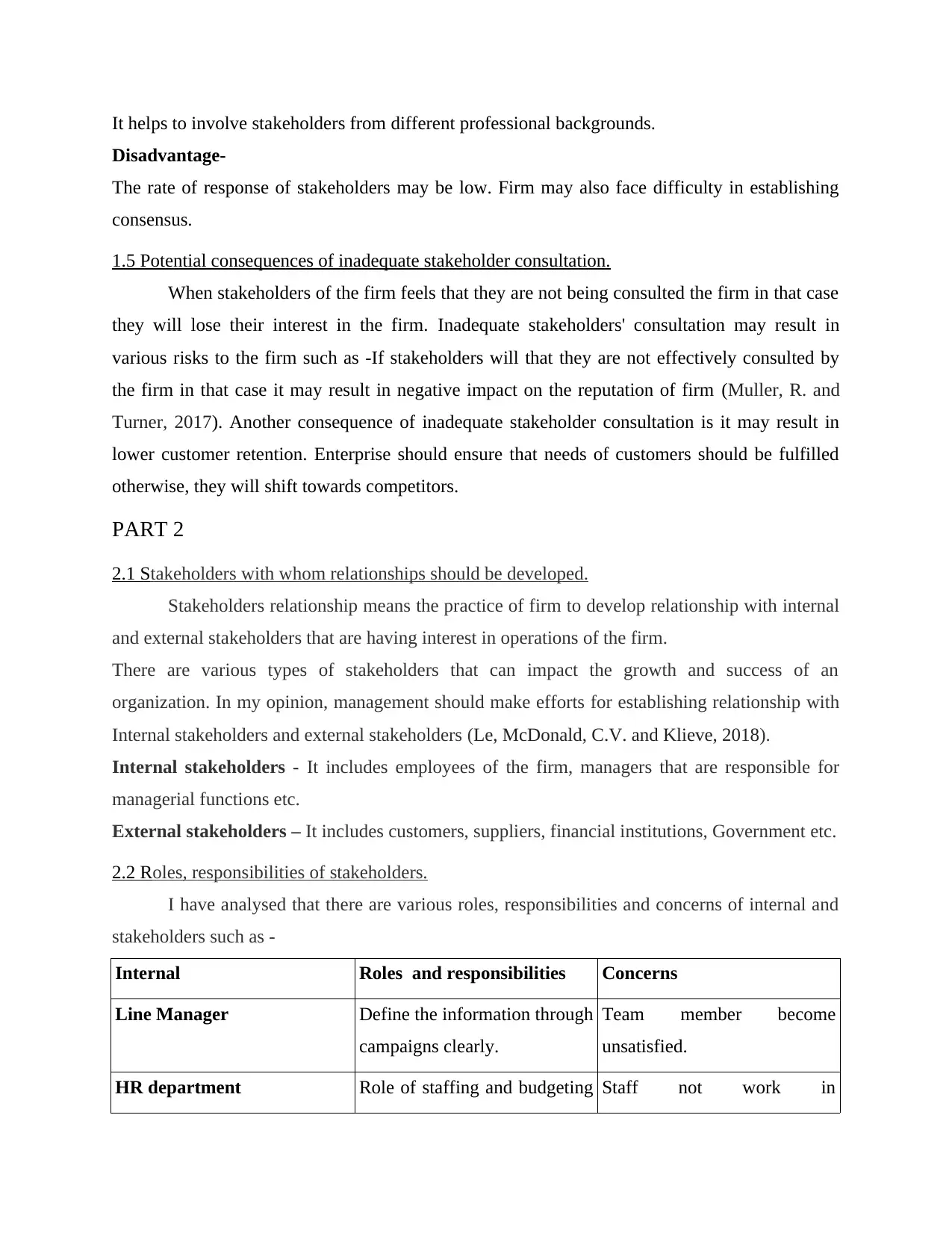
It helps to involve stakeholders from different professional backgrounds.
Disadvantage-
The rate of response of stakeholders may be low. Firm may also face difficulty in establishing
consensus.
1.5 Potential consequences of inadequate stakeholder consultation.
When stakeholders of the firm feels that they are not being consulted the firm in that case
they will lose their interest in the firm. Inadequate stakeholders' consultation may result in
various risks to the firm such as -If stakeholders will that they are not effectively consulted by
the firm in that case it may result in negative impact on the reputation of firm (Muller, R. and
Turner, 2017). Another consequence of inadequate stakeholder consultation is it may result in
lower customer retention. Enterprise should ensure that needs of customers should be fulfilled
otherwise, they will shift towards competitors.
PART 2
2.1 Stakeholders with whom relationships should be developed.
Stakeholders relationship means the practice of firm to develop relationship with internal
and external stakeholders that are having interest in operations of the firm.
There are various types of stakeholders that can impact the growth and success of an
organization. In my opinion, management should make efforts for establishing relationship with
Internal stakeholders and external stakeholders (Le, McDonald, C.V. and Klieve, 2018).
Internal stakeholders - It includes employees of the firm, managers that are responsible for
managerial functions etc.
External stakeholders – It includes customers, suppliers, financial institutions, Government etc.
2.2 Roles, responsibilities of stakeholders.
I have analysed that there are various roles, responsibilities and concerns of internal and
stakeholders such as -
Internal Roles and responsibilities Concerns
Line Manager Define the information through
campaigns clearly.
Team member become
unsatisfied.
HR department Role of staffing and budgeting Staff not work in
Disadvantage-
The rate of response of stakeholders may be low. Firm may also face difficulty in establishing
consensus.
1.5 Potential consequences of inadequate stakeholder consultation.
When stakeholders of the firm feels that they are not being consulted the firm in that case
they will lose their interest in the firm. Inadequate stakeholders' consultation may result in
various risks to the firm such as -If stakeholders will that they are not effectively consulted by
the firm in that case it may result in negative impact on the reputation of firm (Muller, R. and
Turner, 2017). Another consequence of inadequate stakeholder consultation is it may result in
lower customer retention. Enterprise should ensure that needs of customers should be fulfilled
otherwise, they will shift towards competitors.
PART 2
2.1 Stakeholders with whom relationships should be developed.
Stakeholders relationship means the practice of firm to develop relationship with internal
and external stakeholders that are having interest in operations of the firm.
There are various types of stakeholders that can impact the growth and success of an
organization. In my opinion, management should make efforts for establishing relationship with
Internal stakeholders and external stakeholders (Le, McDonald, C.V. and Klieve, 2018).
Internal stakeholders - It includes employees of the firm, managers that are responsible for
managerial functions etc.
External stakeholders – It includes customers, suppliers, financial institutions, Government etc.
2.2 Roles, responsibilities of stakeholders.
I have analysed that there are various roles, responsibilities and concerns of internal and
stakeholders such as -
Internal Roles and responsibilities Concerns
Line Manager Define the information through
campaigns clearly.
Team member become
unsatisfied.
HR department Role of staffing and budgeting Staff not work in
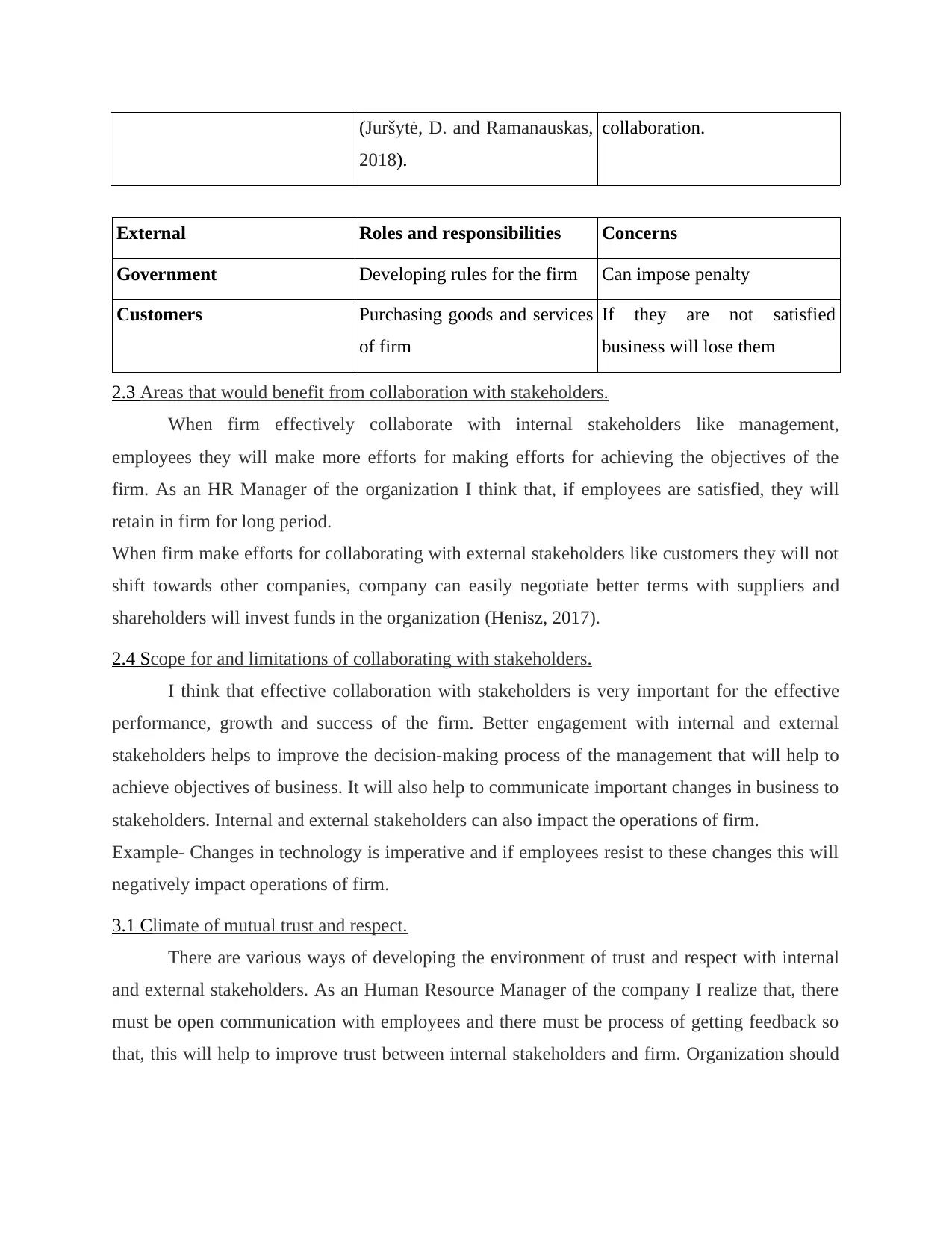
(Juršytė, D. and Ramanauskas,
2018).
collaboration.
External Roles and responsibilities Concerns
Government Developing rules for the firm Can impose penalty
Customers Purchasing goods and services
of firm
If they are not satisfied
business will lose them
2.3 Areas that would benefit from collaboration with stakeholders.
When firm effectively collaborate with internal stakeholders like management,
employees they will make more efforts for making efforts for achieving the objectives of the
firm. As an HR Manager of the organization I think that, if employees are satisfied, they will
retain in firm for long period.
When firm make efforts for collaborating with external stakeholders like customers they will not
shift towards other companies, company can easily negotiate better terms with suppliers and
shareholders will invest funds in the organization (Henisz, 2017).
2.4 Scope for and limitations of collaborating with stakeholders.
I think that effective collaboration with stakeholders is very important for the effective
performance, growth and success of the firm. Better engagement with internal and external
stakeholders helps to improve the decision-making process of the management that will help to
achieve objectives of business. It will also help to communicate important changes in business to
stakeholders. Internal and external stakeholders can also impact the operations of firm.
Example- Changes in technology is imperative and if employees resist to these changes this will
negatively impact operations of firm.
3.1 Climate of mutual trust and respect.
There are various ways of developing the environment of trust and respect with internal
and external stakeholders. As an Human Resource Manager of the company I realize that, there
must be open communication with employees and there must be process of getting feedback so
that, this will help to improve trust between internal stakeholders and firm. Organization should
2018).
collaboration.
External Roles and responsibilities Concerns
Government Developing rules for the firm Can impose penalty
Customers Purchasing goods and services
of firm
If they are not satisfied
business will lose them
2.3 Areas that would benefit from collaboration with stakeholders.
When firm effectively collaborate with internal stakeholders like management,
employees they will make more efforts for making efforts for achieving the objectives of the
firm. As an HR Manager of the organization I think that, if employees are satisfied, they will
retain in firm for long period.
When firm make efforts for collaborating with external stakeholders like customers they will not
shift towards other companies, company can easily negotiate better terms with suppliers and
shareholders will invest funds in the organization (Henisz, 2017).
2.4 Scope for and limitations of collaborating with stakeholders.
I think that effective collaboration with stakeholders is very important for the effective
performance, growth and success of the firm. Better engagement with internal and external
stakeholders helps to improve the decision-making process of the management that will help to
achieve objectives of business. It will also help to communicate important changes in business to
stakeholders. Internal and external stakeholders can also impact the operations of firm.
Example- Changes in technology is imperative and if employees resist to these changes this will
negatively impact operations of firm.
3.1 Climate of mutual trust and respect.
There are various ways of developing the environment of trust and respect with internal
and external stakeholders. As an Human Resource Manager of the company I realize that, there
must be open communication with employees and there must be process of getting feedback so
that, this will help to improve trust between internal stakeholders and firm. Organization should
⊘ This is a preview!⊘
Do you want full access?
Subscribe today to unlock all pages.

Trusted by 1+ million students worldwide
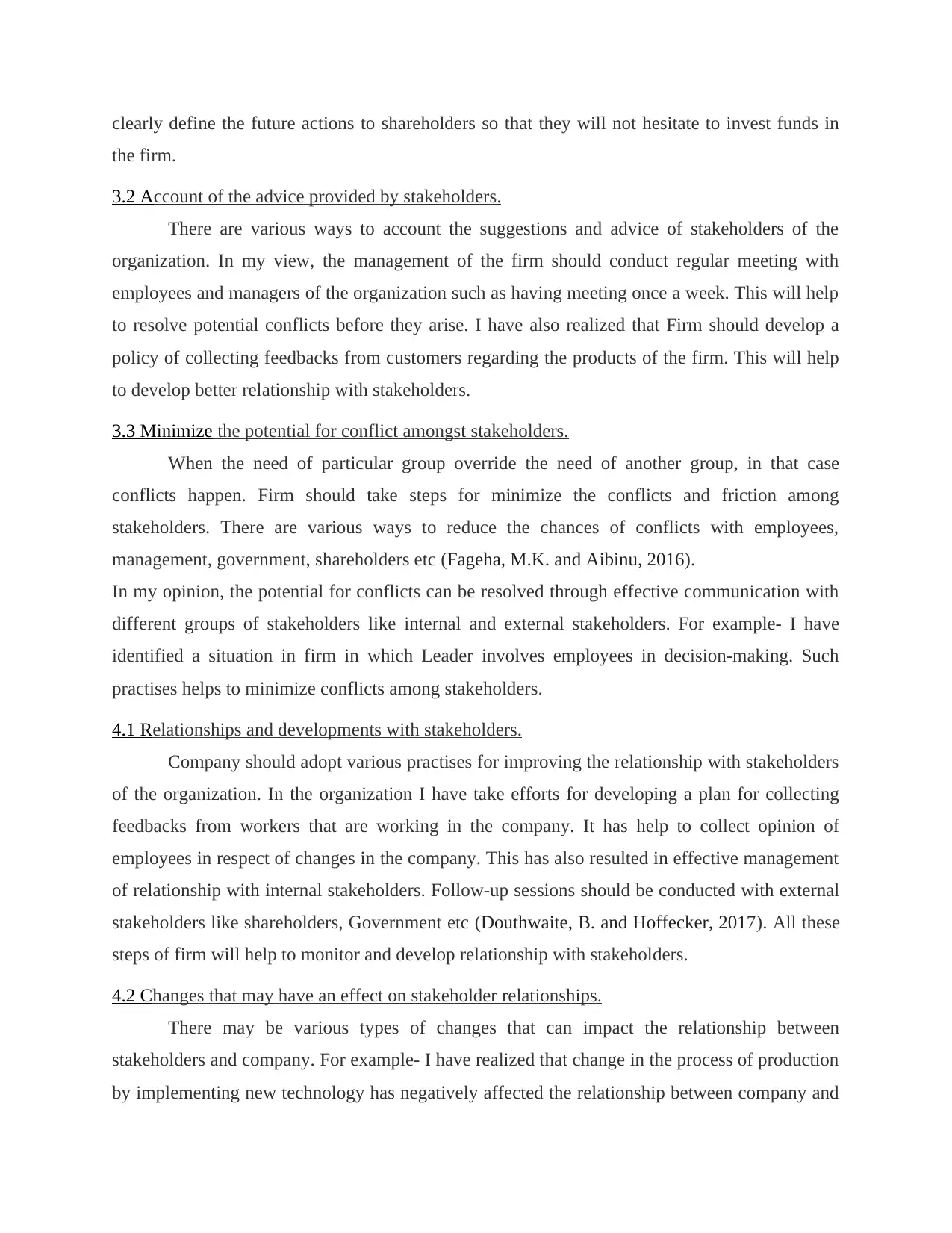
clearly define the future actions to shareholders so that they will not hesitate to invest funds in
the firm.
3.2 Account of the advice provided by stakeholders.
There are various ways to account the suggestions and advice of stakeholders of the
organization. In my view, the management of the firm should conduct regular meeting with
employees and managers of the organization such as having meeting once a week. This will help
to resolve potential conflicts before they arise. I have also realized that Firm should develop a
policy of collecting feedbacks from customers regarding the products of the firm. This will help
to develop better relationship with stakeholders.
3.3 Minimize the potential for conflict amongst stakeholders.
When the need of particular group override the need of another group, in that case
conflicts happen. Firm should take steps for minimize the conflicts and friction among
stakeholders. There are various ways to reduce the chances of conflicts with employees,
management, government, shareholders etc (Fageha, M.K. and Aibinu, 2016).
In my opinion, the potential for conflicts can be resolved through effective communication with
different groups of stakeholders like internal and external stakeholders. For example- I have
identified a situation in firm in which Leader involves employees in decision-making. Such
practises helps to minimize conflicts among stakeholders.
4.1 Relationships and developments with stakeholders.
Company should adopt various practises for improving the relationship with stakeholders
of the organization. In the organization I have take efforts for developing a plan for collecting
feedbacks from workers that are working in the company. It has help to collect opinion of
employees in respect of changes in the company. This has also resulted in effective management
of relationship with internal stakeholders. Follow-up sessions should be conducted with external
stakeholders like shareholders, Government etc (Douthwaite, B. and Hoffecker, 2017). All these
steps of firm will help to monitor and develop relationship with stakeholders.
4.2 Changes that may have an effect on stakeholder relationships.
There may be various types of changes that can impact the relationship between
stakeholders and company. For example- I have realized that change in the process of production
by implementing new technology has negatively affected the relationship between company and
the firm.
3.2 Account of the advice provided by stakeholders.
There are various ways to account the suggestions and advice of stakeholders of the
organization. In my view, the management of the firm should conduct regular meeting with
employees and managers of the organization such as having meeting once a week. This will help
to resolve potential conflicts before they arise. I have also realized that Firm should develop a
policy of collecting feedbacks from customers regarding the products of the firm. This will help
to develop better relationship with stakeholders.
3.3 Minimize the potential for conflict amongst stakeholders.
When the need of particular group override the need of another group, in that case
conflicts happen. Firm should take steps for minimize the conflicts and friction among
stakeholders. There are various ways to reduce the chances of conflicts with employees,
management, government, shareholders etc (Fageha, M.K. and Aibinu, 2016).
In my opinion, the potential for conflicts can be resolved through effective communication with
different groups of stakeholders like internal and external stakeholders. For example- I have
identified a situation in firm in which Leader involves employees in decision-making. Such
practises helps to minimize conflicts among stakeholders.
4.1 Relationships and developments with stakeholders.
Company should adopt various practises for improving the relationship with stakeholders
of the organization. In the organization I have take efforts for developing a plan for collecting
feedbacks from workers that are working in the company. It has help to collect opinion of
employees in respect of changes in the company. This has also resulted in effective management
of relationship with internal stakeholders. Follow-up sessions should be conducted with external
stakeholders like shareholders, Government etc (Douthwaite, B. and Hoffecker, 2017). All these
steps of firm will help to monitor and develop relationship with stakeholders.
4.2 Changes that may have an effect on stakeholder relationships.
There may be various types of changes that can impact the relationship between
stakeholders and company. For example- I have realized that change in the process of production
by implementing new technology has negatively affected the relationship between company and
Paraphrase This Document
Need a fresh take? Get an instant paraphrase of this document with our AI Paraphraser
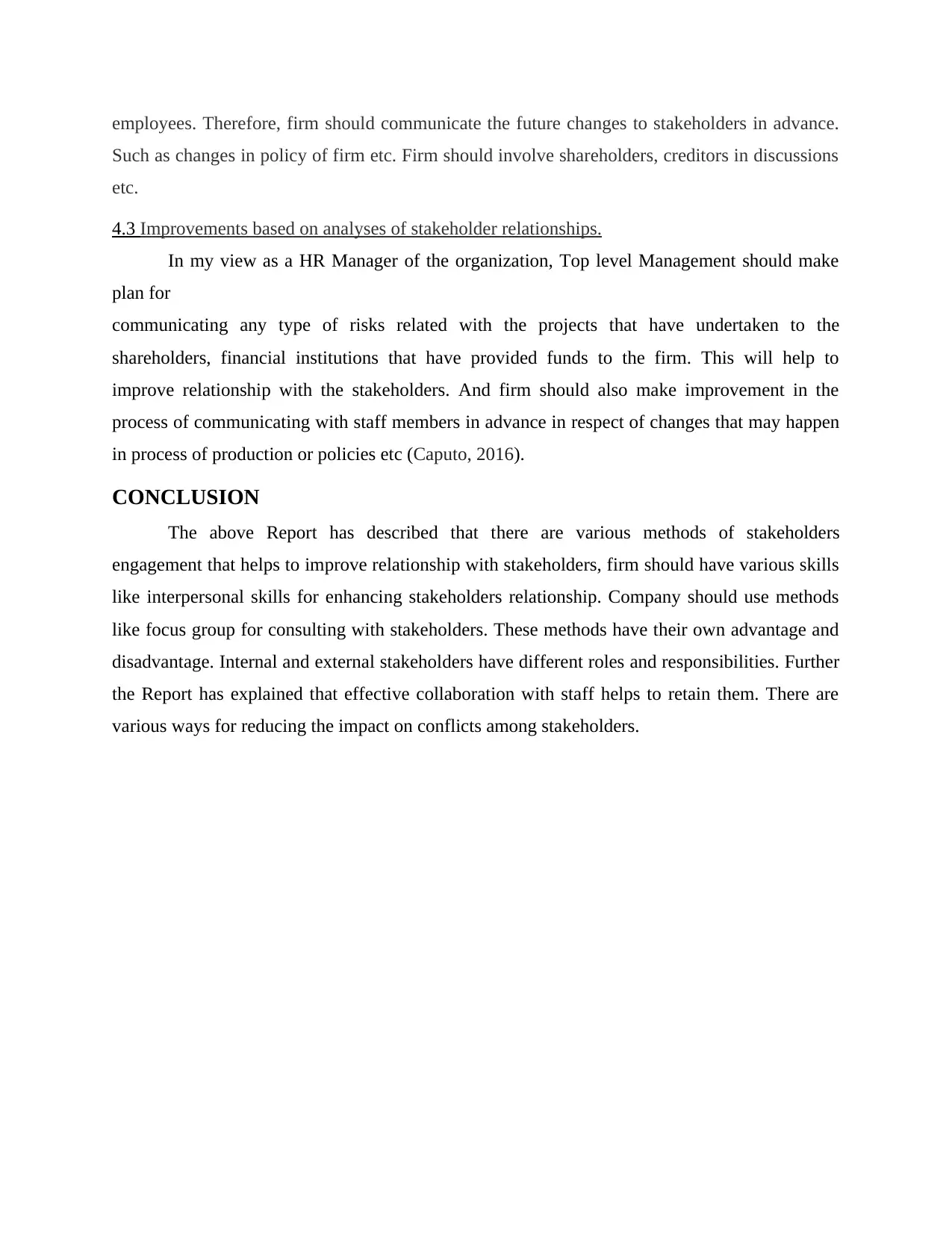
employees. Therefore, firm should communicate the future changes to stakeholders in advance.
Such as changes in policy of firm etc. Firm should involve shareholders, creditors in discussions
etc.
4.3 Improvements based on analyses of stakeholder relationships.
In my view as a HR Manager of the organization, Top level Management should make
plan for
communicating any type of risks related with the projects that have undertaken to the
shareholders, financial institutions that have provided funds to the firm. This will help to
improve relationship with the stakeholders. And firm should also make improvement in the
process of communicating with staff members in advance in respect of changes that may happen
in process of production or policies etc (Caputo, 2016).
CONCLUSION
The above Report has described that there are various methods of stakeholders
engagement that helps to improve relationship with stakeholders, firm should have various skills
like interpersonal skills for enhancing stakeholders relationship. Company should use methods
like focus group for consulting with stakeholders. These methods have their own advantage and
disadvantage. Internal and external stakeholders have different roles and responsibilities. Further
the Report has explained that effective collaboration with staff helps to retain them. There are
various ways for reducing the impact on conflicts among stakeholders.
Such as changes in policy of firm etc. Firm should involve shareholders, creditors in discussions
etc.
4.3 Improvements based on analyses of stakeholder relationships.
In my view as a HR Manager of the organization, Top level Management should make
plan for
communicating any type of risks related with the projects that have undertaken to the
shareholders, financial institutions that have provided funds to the firm. This will help to
improve relationship with the stakeholders. And firm should also make improvement in the
process of communicating with staff members in advance in respect of changes that may happen
in process of production or policies etc (Caputo, 2016).
CONCLUSION
The above Report has described that there are various methods of stakeholders
engagement that helps to improve relationship with stakeholders, firm should have various skills
like interpersonal skills for enhancing stakeholders relationship. Company should use methods
like focus group for consulting with stakeholders. These methods have their own advantage and
disadvantage. Internal and external stakeholders have different roles and responsibilities. Further
the Report has explained that effective collaboration with staff helps to retain them. There are
various ways for reducing the impact on conflicts among stakeholders.

REFERENCES
Books and Journals -
Caputo, F., 2016, September. A focus on company-stakeholder relationships in the light of the
stakeholder engagement framework. In 9th Annual Conference of the EuroMed Academy
of Business.
Douthwaite, B. and Hoffecker, E., 2017. Towards a complexity-aware theory of change for
participatory research programs working within agricultural innovation
systems. Agricultural Systems. 155. pp.88-102.
Fageha, M.K. and Aibinu, A.A., 2016. Identifying stakeholders’ involvement that enhances
project scope definition completeness in Saudi Arabian public building projects. Built
Environment Project and Asset Management. 6(1). pp.6-29.
Henisz, W.J., 2017. Corporate diplomacy: Building reputations and relationships with external
stakeholders.Routledge.
Juršytė, D. and Ramanauskas, G., 2018. Practices and Policies in Building Relationships
with Stakeholders. In Marketing Strategies for Central and Eastern Europe (pp. 133-173).
Routledge.
Le, A.H., McDonald, C.V. and Klieve, H., 2018. Hospitality higher education in Vietnam:
Voices from stakeholders. Tourism management perspectives. 27. pp.68-82.
Muller, R. and Turner, J.R., 2017. Project-oriented leadership. Routledge.
Ramanauskas, G. and Juršytė, D., 2017. Practices and Policies in Building Relationships with
Stakeholders. In Industries and Markets in Central and Eastern Europe (pp. 157-198).
Routledge.
Sanogo, V., Harrington, J. and Siddiqui, Z., 2018. Information Sources, Awareness, and
Perception Levels About Climate Change Impacts: A Case Study on Florida
Stakeholders. International Journal of Economy, Energy and Environment. 3(2). p.6.
Stubbs, J. and Warnaby, G., 2015. Rethinking place branding from a practice perspective:
working with stakeholders. In Rethinking place branding (pp. 101-118). Springer, Cham.
Online -
Strategies for improving relationship with Stakeholders. 2017. [Online] Available Through :
<https://www.knowledgehut.com/blog/digital-marketing/best-strategies-strengthening-
relationships-stakeholders>
Books and Journals -
Caputo, F., 2016, September. A focus on company-stakeholder relationships in the light of the
stakeholder engagement framework. In 9th Annual Conference of the EuroMed Academy
of Business.
Douthwaite, B. and Hoffecker, E., 2017. Towards a complexity-aware theory of change for
participatory research programs working within agricultural innovation
systems. Agricultural Systems. 155. pp.88-102.
Fageha, M.K. and Aibinu, A.A., 2016. Identifying stakeholders’ involvement that enhances
project scope definition completeness in Saudi Arabian public building projects. Built
Environment Project and Asset Management. 6(1). pp.6-29.
Henisz, W.J., 2017. Corporate diplomacy: Building reputations and relationships with external
stakeholders.Routledge.
Juršytė, D. and Ramanauskas, G., 2018. Practices and Policies in Building Relationships
with Stakeholders. In Marketing Strategies for Central and Eastern Europe (pp. 133-173).
Routledge.
Le, A.H., McDonald, C.V. and Klieve, H., 2018. Hospitality higher education in Vietnam:
Voices from stakeholders. Tourism management perspectives. 27. pp.68-82.
Muller, R. and Turner, J.R., 2017. Project-oriented leadership. Routledge.
Ramanauskas, G. and Juršytė, D., 2017. Practices and Policies in Building Relationships with
Stakeholders. In Industries and Markets in Central and Eastern Europe (pp. 157-198).
Routledge.
Sanogo, V., Harrington, J. and Siddiqui, Z., 2018. Information Sources, Awareness, and
Perception Levels About Climate Change Impacts: A Case Study on Florida
Stakeholders. International Journal of Economy, Energy and Environment. 3(2). p.6.
Stubbs, J. and Warnaby, G., 2015. Rethinking place branding from a practice perspective:
working with stakeholders. In Rethinking place branding (pp. 101-118). Springer, Cham.
Online -
Strategies for improving relationship with Stakeholders. 2017. [Online] Available Through :
<https://www.knowledgehut.com/blog/digital-marketing/best-strategies-strengthening-
relationships-stakeholders>
⊘ This is a preview!⊘
Do you want full access?
Subscribe today to unlock all pages.

Trusted by 1+ million students worldwide
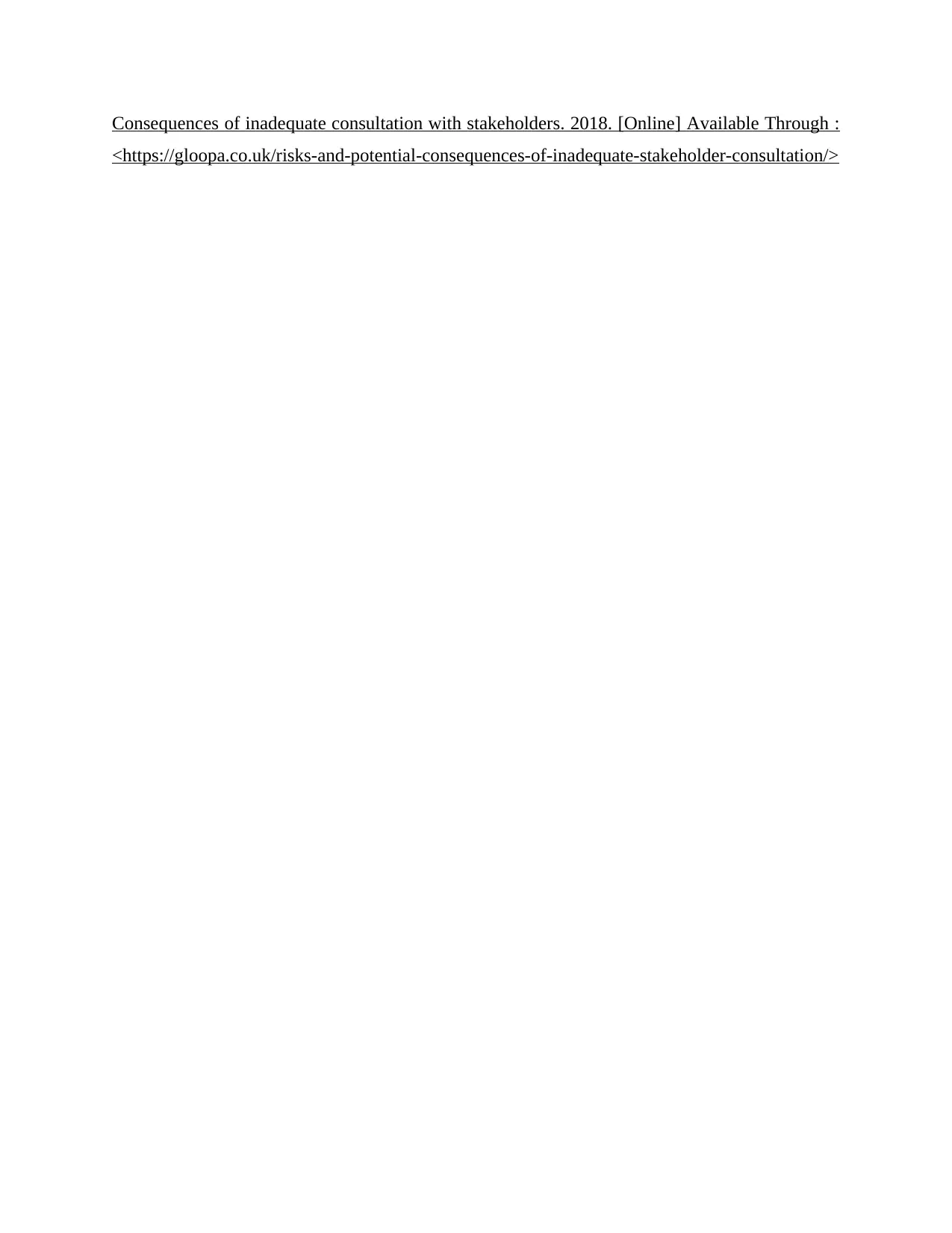
Consequences of inadequate consultation with stakeholders. 2018. [Online] Available Through :
<https://gloopa.co.uk/risks-and-potential-consequences-of-inadequate-stakeholder-consultation/>
<https://gloopa.co.uk/risks-and-potential-consequences-of-inadequate-stakeholder-consultation/>
1 out of 10
Related Documents
Your All-in-One AI-Powered Toolkit for Academic Success.
+13062052269
info@desklib.com
Available 24*7 on WhatsApp / Email
![[object Object]](/_next/static/media/star-bottom.7253800d.svg)
Unlock your academic potential
Copyright © 2020–2025 A2Z Services. All Rights Reserved. Developed and managed by ZUCOL.

![[Year] [Company Name] Stakeholder Analysis & Management Portfolio](/_next/image/?url=https%3A%2F%2Fdesklib.com%2Fmedia%2Fimages%2Fjx%2F324f92f0ec244632a823c730fd097066.jpg&w=256&q=75)



